Abstract
THE phenomenon of long-term potentiation (LTP), a long lasting increase in the strength of synaptic transmission which is due to brief, repetitive activation of excitatory afferent fibres, is one of the most striking examples of synaptic plasticity in the mammalian brain. In the CA1 region of the hippocampus, the induction of LTP requires activation of NMDA (N-methyl-D-aspartate) receptors by synaptically released glutamate1 with concomitant postsynaptic membrane depolarization2-5. This relieves the voltage-dependent magnesium block of the NMD A-receptor ion channel6,7, allowing calcium to flow into the dendritic spine8-10. Although calcium has been shown to be a necessary trigger for LTP (refs 11,12), little is known about the immediate biochemical processes that are activated by calcium and are responsible for LTP. The most attractive candidates have been calcium/cal-modulin-dependent protein kinase II (CaM-KII) (refs 13-16), protein kinase C (refs 17-19), and the calcium-dependent protease, calpain20. Extracellular application of protein kinase inhibitors to the hippocampal slice preparation blocks the induction of LTP (refs 21-23) but it is unclear whether this is due to a pre- and/or postsynaptic action. We have found that intracellular injection into CA1 pyramidal cells of the protein kinase inhibitor H-7, or of the calmodulin antagonist calmidazolium, blocks LTP. Further-more, LTP is blocked by the injection of synthetic peptides that are potent calmodulin antagonists and inhibit CaM-KII auto- and substrate phosphorylation. These findings demonstrate that in the postsynaptic cell both activation of calmodulin and kinase activity are required for the generation of LTP, and focus further attention on the potential role of CaM-KII in LTP.
This is a preview of subscription content, access via your institution
Access options
Subscribe to this journal
Receive 51 print issues and online access
$199.00 per year
only $3.90 per issue
Buy this article
- Purchase on Springer Link
- Instant access to full article PDF
Prices may be subject to local taxes which are calculated during checkout
Similar content being viewed by others
References
Collingridge, G. L., Kehl, S. J. & McLennan, H. J. Physiol., Lond. 334, 33–46 (1983).
Gustafsson, B., Wigström, H., Abraham, W. C. & Huang, Y.-Y. J. Neurosci. 7, 774–780 (1987).
Kelso, S. R., Ganong A. H. & Brown, T. H. Proc. natn. Acad. Sci. U.S.A. 83, 5326–5330 (1986).
Malinow, R. & Miller, J. P. Nature 320, 529–530 (1986).
Sastry, B. R., Goh, J. W. & Auyeung, A. Science 232, 988–990 (1986).
Nowak, L., Bregestovski, P., Ascher, P., Herbet, A. & Prochiantz, A. Nature 307, 462–465 (1984).
Mayer, M. L., Westbrook, G. L. & Guthrie, P. B. Nature 309, 261–263 (1984).
Ascher, P. & Nowak, L. J. Physiol., Lond. 399, 247–266 (1988).
Jahr, C. E. & Stevens, C. F. Nature 325, 522–525 (1987).
Mayer, M. L. & Westbrook, G. L. J. Physiol., Lond 394, 501–527 (1987).
Lynch, G., Larson, J., Kelso, S., Barrionuevo, G. & Schottler, F. Nature 305, 719–721 (1983).
Malenka, R. C., Kauer, J. A., Zucker, R. S. & Nicoll, R. A. Science 242, 81–84 (1988).
Kennedy, M. B., Bennett, M. K. & Erondu, N. E. Proc. natn. Acad. Sci. U.S.A. 80, 7357–7361 (1983).
Kelly, P. T., McGuinness, T. L. & Greengard, P. Proc. natn. Acad. Sci. U.S.A. 81, 945–949 (1984).
Miller, S. G. & Kennedy, M. B. Cell 44, 861–870 (1986).
Lisman, J. E. & Goldring, M. A. Proc. natn. Acad. Sci. U.S.A. 85, 5320–5324 (1988).
Akers, R. E., Lovinger, D. M., Colley, P. A., Linden, D. J. & Routtenberg, A. Science 231, 587–589 (1986).
Malenka, R. C., Madison, D. V. & Nicoll, R. A. Nature 321, 175–177 (1986).
Hu, G. Y. et al. Nature 328, 426–429 (1987).
Lynch, G. & Baudry, M. Science 224, 1057–1063 (1984).
Malinow, R., Madison, D. V. & Tsien, R. W. Nature 335, 820–824 (1988).
Reymann, K. G., Frey, U., Jork, R. & Matthies, H. Brain Res. 440, 305–314 (1988).
Lovinger, D. M., Wong, K. L., Murakami, K. & Routtenberg, A. Brain Res. 436, 177–183 (1987).
Hidaka, H., Inagaki, M., Kawamoto, S. & Sasaki, Y. Biochemistry 23, 5036–5041 (1984).
Mody, I., Baimbridge, K. G. & Miller, J. J. Neuropharmacology 23, 625–631 (1984).
Finn, R. C., Browning, M. & Lynch, G. Neurosci. Lett. 19, 103–108 (1980).
Reymann, K. G., Brodemann, R., Kase, H. & Matthies, H. Brain Res. 461, 388–392 (1988).
Kuo, J. F., Schatzman, R. C., Turner, R. S. & Mazzei, G. J. Molec. cell. Endocrinol. 35, 65–73 (1984).
Greenberg, D. A., Carpender, C. L. & Messing, R. O. Brain Res. 404, 401–404 (1987).
Kelly, P. T., Weinberger, R. P. & Waxham, M. N. Proc. natn. Acad Sci. U.S.A. 85, 4991–4995 (1988).
Saitoh, T. & Schwartz, J. H. J. Cell Biol. 100, 835–842 (1985).
Kauer, J. A., Malenka, R. C. & Nicoll, R. A. Neuron 1, 911–917 (1988).
Muller, D., Joly, M. & Lynch, G. Science 242, 1694–1697 (1988).
Muller, D. & Lynch, G. Proc. natn. Acad. Sci. U.S.A. 85, 9346–9350 (1988).
Davies, S. N., Lester, R. A. J., Reymann, K. G. & Collingridge, G. L. Nature 338, 500–503 (1989).
Kauer, J. A., Malenka, R. C. & Nicoll, R. A. Nature 334, 250–252 (1988).
Williams, J. H. & Bliss, T. V. P. Neurosci. Lett. 88, 81–85 (1988).
Wooten, M. W., Vandenplas, M. & Nel, A. E. Eur. J. Biochem. 164, 461–467 (1987).
Nicoll, R, A. & Alger, B. E. J. Neurosci. Meth. 4, 153–156 (1981).
Author information
Authors and Affiliations
Rights and permissions
About this article
Cite this article
Malenka, R., Kauer, J., Perkel, D. et al. An essential role for postsynaptic calmodulin and protein kinase activity in long-term potentiation. Nature 340, 554–557 (1989). https://doi.org/10.1038/340554a0
Received:
Accepted:
Issue Date:
DOI: https://doi.org/10.1038/340554a0
This article is cited by
-
UNC-43/CaMKII-triggered anterograde signals recruit GABAARs to mediate inhibitory synaptic transmission and plasticity at C. elegans NMJs
Nature Communications (2023)
-
CaMKIIα-driven, phosphatase-checked postsynaptic plasticity via phase separation
Cell Research (2021)
-
Comparison of Effects of Spatial and Non-Spatial Memory Acquisition on the CaMKII Pathway During Hypothyroidism and Nicotine Treatment
Molecular Neurobiology (2020)
-
A calcium-influx-dependent plasticity model exhibiting multiple STDP curves
Journal of Computational Neuroscience (2020)
-
The CaMKII/NMDA receptor complex controls hippocampal synaptic transmission by kinase-dependent and independent mechanisms
Nature Communications (2018)
Comments
By submitting a comment you agree to abide by our Terms and Community Guidelines. If you find something abusive or that does not comply with our terms or guidelines please flag it as inappropriate.



